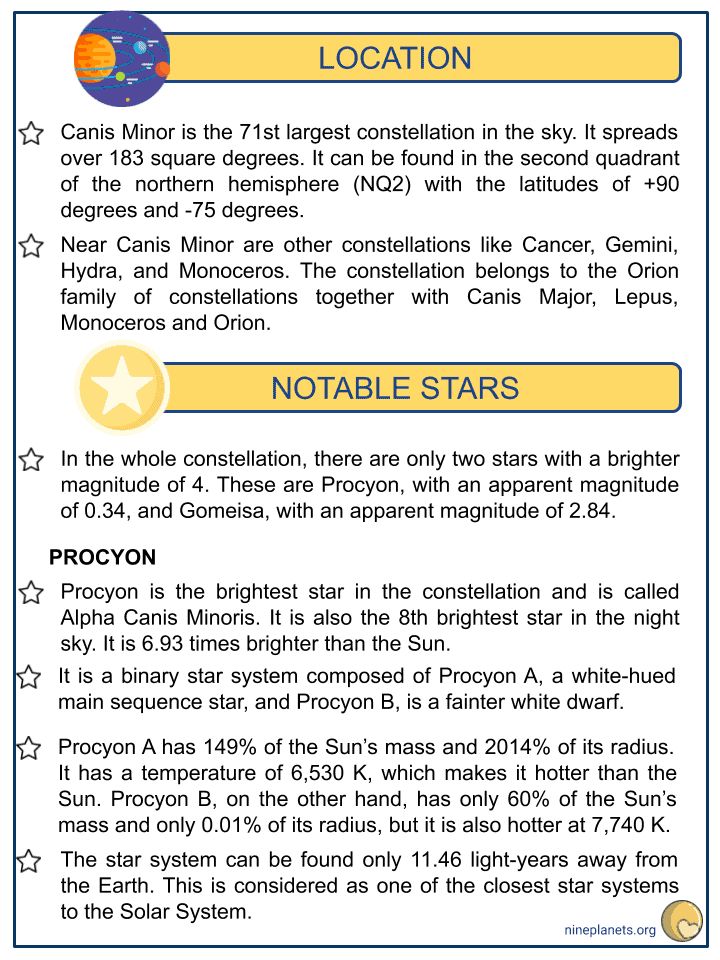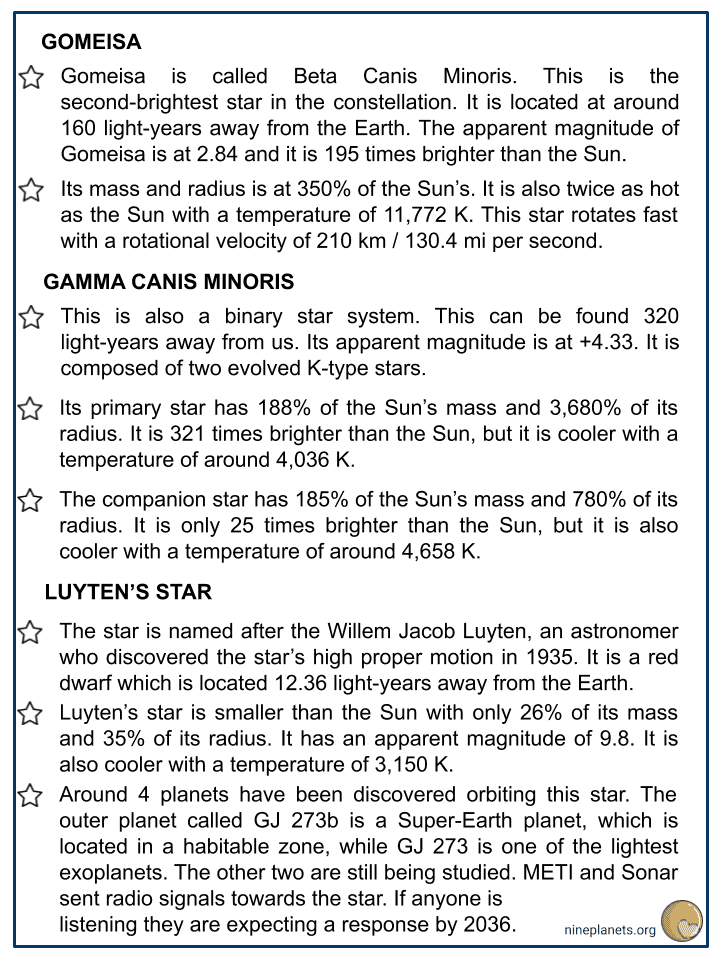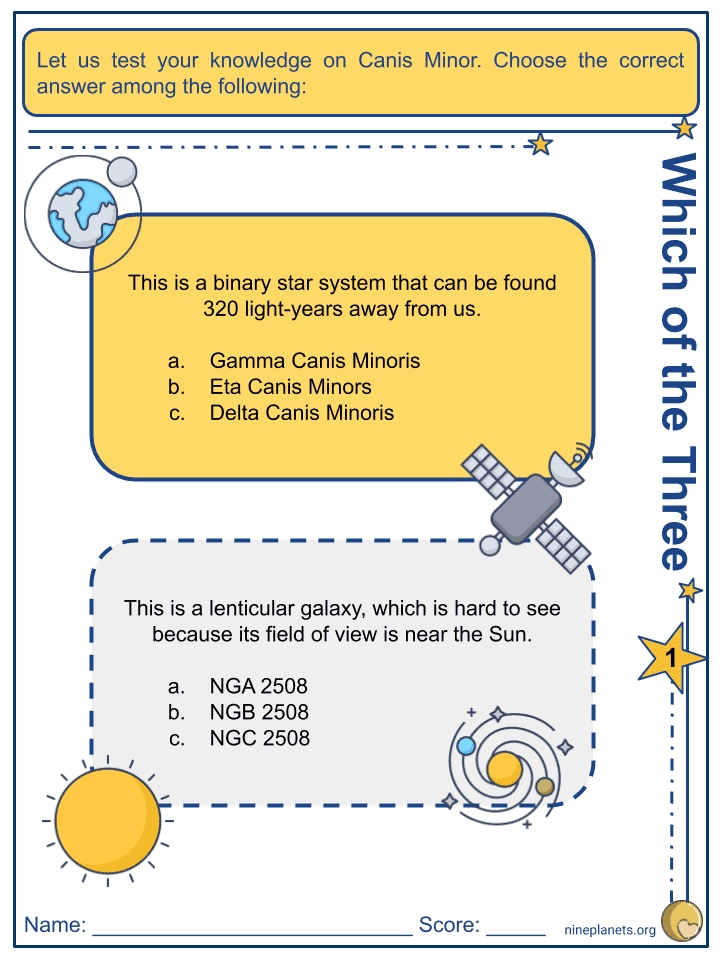Download Canis Minor Constellation Worksheets
Click the button below to get instant access to these premium worksheets for use in the classroom or at a home.

This worksheet can be edited by Premium members using the free Google Slides online software. Click the Edit button above to get started.
Download free sample
Not ready to purchase a subscription yet? Click here to download a FREE sample of this worksheet pack.
Resource Examples
Click any of the example images below to view a larger version.




Key Facts & Information
- Canis Minor is a small constellation that can be found in the northern celestial hemisphere.
- In Latin, Canis Minor means the “Lesser Dog”, which is in contrast with the meaning of Canis Major, “Greater Dog”. Both constellations are associated with following the Orion constellation.
- Canis Minor was first cataloged by Ptolemy, a Greco-Roman astronomer as an asterism in his 2nd century Almagest as one of the 48 constellations.
- It is the 71st constellation out of the 88 modern constellations in terms of size. It stretches for around 183 square degrees.
- The brightest stars, Procyon and Gomeisa were called “MASH.TAB.BA”, or the twins, in the Three Stars Each tablet dating from around 1100 BC. These stars were later associated with the deities of Babylonian mythos, Lulal and Latarak.
- In Greek mythology, Canis Minor is associated with the Teumessian Fox, a beast that was turned into a stone by Zeus together with its hunter named Laelaps. Zeus placed them in the Sky. Laelaps became Canis Major and Teumessian Fox became Canis Minor.
- Canis Minor is strongly associated with the Greek Uranographic tradition, but the origins of this constellation can be dated back to Ancient Mesopotamia.
Location
- Canis Minor is the 71st largest constellation in the sky. It spreads over 183 square degrees. It can be found in the second quadrant of the northern hemisphere (NQ2) with the latitudes of +90 degrees and -75 degrees.
- Near Canis Minor are other constellations like Cancer, Gemini, Hydra, and Monoceros. The constellation belongs to the Orion family of constellations together with Canis Major, Lepus, Monoceros and Orion.
Notable Stars
- In the whole constellation, there are only two stars with a brighter magnitude of 4. These are Procyon, with an apparent magnitude of 0.34, and Gomeisa, with an apparent magnitude of 2.84.
- PROCYON
- Procyon is the brightest star in the constellation and is called Alpha Canis Minoris. It is also the 8th brightest star in the night sky. It is 6.93 times brighter than the Sun.
- It is a binary star system composed of Procyon A, a white-hued main sequence star, and Procyon B, is a fainter white dwarf.
- Procyon A has 149% of the Sun’s mass and 2014% of its radius. It has a temperature of 6,530 K, which makes it hotter than the Sun. Procyon B, on the other hand, has only 60% of the Sun’s mass and only 0.01% of its radius, but it is also hotter at 7,740 K.
- The star system can be found only 11.46 light-years away from the Earth. This is considered as one of the closest star systems to the Solar System.
- GOMEISA
- Gomeisa is called Beta Canis Minoris. This is the second-brightest star in the constellation. It is located at around 160 light-years away from the Earth. The apparent magnitude of Gomeisa is at 2.84 and it is 195 times brighter than the Sun.
- Its mass and radius is at 350% of the Sun’s. It is also twice as hot as the Sun with a temperature of 11,772 K. This star rotates fast with a rotational velocity of 210 km / 130.4 mi per second.
- GAMMA CANIS MINORIS
- This is also a binary star system. This can be found 320 light-years away from us. Its apparent magnitude is at +4.33. It is composed of two evolved K-type stars.
- Its primary star has 188% of the Sun’s mass and 3,680% of its radius. It is 321 times brighter than the Sun, but it is cooler with a temperature of around 4,036 K.
- The companion star has 185% of the Sun’s mass and 780% of its radius. It is only 25 times brighter than the Sun, but it is also cooler with a temperature of around 4,658 K.
- LUYTEN’S STAR
- The star is named after the Willem Jacob Luyten, an astronomer who discovered the star’s high proper motion in 1935. It is a red dwarf which is located 12.36 light-years away from the Earth.
- Luyten’s star is smaller than the Sun with only 26% of its mass and 35% of its radius. It has an apparent magnitude of 9.8. It is also cooler with a temperature of 3,150 K.
- Around 4 planets have been discovered orbiting this star. The outer planet called GJ 273b is a Super-Earth planet, which is located in a habitable zone, while GJ 273 is one of the lightest exoplanets. The other two are still being studied. METI and Sonar sent radio signals towards the star. If anyone is listening they are expecting a response by 2036.
- EPSILON CANIS MINORIS
- Epsilon Canis Minoris is suspected to be a binary star system. It is an evolved G-type bright giant star, which is located at around 770 light-years away from the Earth. It has a magnitude of 5.
- Its mass is at around 463% of the Sun’s, 455% of its radius and 1,086 times brighter with a temperature of 4,916 K.
- ETA CANIS MINORIS
- This is also a binary star system. It is composed of a yellow-white F-type giant star and an eleventh-magnitude star. It has an apparent magnitude of 5.25.
- Its two stars are 4 arcseconds away from each other. It takes 4,000 years for the companion star to orbit the primary star.
- Eta Canis Minoris has 216% of the Sun’s mass, 5,750% of its radius and 57.5 times brighter than the Sun.
- DELTA CANIS MINORIS
- Delta Canis Minoris is designated to three different stars. Delta 1 Canis Minoris is a F-type main-sequence, yellow-white hued star located around 760 light-years away from us. It has a magnitude of +5.25 and is 319 times brighter than the Sun.
- Delta 2 Canis Minoris is an F-type main-sequence star located 141 light-years away from us. It has a magnitude of 5.589 and is 10 times brighter than the Sun. It has 163% of its mass, 185% of its radius and rotates at 113 km / 70.2 mi per second.
- Delta 3 Canis Minoris is a B-type main-sequence, white-hued star located 730 light-years away from us. It has a magnitude of +5.81 and is 175 times brighter than the Sun. It has 316% of the Sun’s mass and 210% of its radius and a temperature of 9,908 K. It rotates at 259 km / 160.9 mi per second.
- ZETA CANIS MINORIS
- This is a blue-white B-type bright giant star which is classified as a Mercury-Manganese star because of the overabundance of these elements in its spectrum.
- It is located 620 light-years away from us. It also has a magnitude of 5.13. It is 490 times brighter than Sun and it has 398% of its mass. It is more than twice as hot as the Sun with a temperature of 13,500 K.
- HD 66141
- HD 66141 is an orange K-type giant located around 222 light-years away from us. It has been discovered that there is one planet that orbits this star.
- It has an apparent magnitude of +4.39 and is 174 times brighter than the Sun.
- Its mass is 110% of the Sun’s and 2,140% of its radius. Its temperature is at 4,305 K which makes it cooler than the Sun.
- BC CANIS MINORIS
- BC Canis Minoris is a reddish variable star. It has an apparent visual magnitude of around 6.30, but this fluctuates.
- It can be found at around 520 light-years away from the Earth, but it can be seen that it is moving closely to us.
- It an aging red star that is 496.7 times brighter than the Sun. It has 6,040% of the Sun’s radius, but it is cooler with a temperature of 3,507 K.
Deep-Sky Objects
- NGC 2508
- This is lenticular galaxy which is located at 75.7 megaparsecs away from the Earth. It is quite hard to observe because its field of view is near the Sun.
- It has an apparent magnitude of 10.285.
- NEBULA ABELL 24
- This is a faint planetary nebula which is located at around 1,730 light-years away from us. It stretches for around 6 arcminutes.
- It was discovered by an astronomer named George Abell.
Meteor Shower
- There is only one meteor shower which is associated with Canis Minor.
- This meteor shower peaks around December 10 and 11 and lasts until December 4 to 15.
- This is the 11 Canis Minoris which is also called Beta Canis Minorids.
Did You Know?
- In Ancient Egypt, they associated Canis Minor with Anubis. Anubis is the jackal god. He has the head of a jackal but the body of a human. He is the ancient Egyptian god of the dead.
- There were other alternative names that were suggested by Johann Bayer for this constellation. These are Fovea, the pit, and Morus, Sycamine Tree.
- There are times when Canis Minor is confused with Canis Major. It is named Canis Orionis which means Orion’s Dog.
- In Chinese astronomy, the stars in the constellation of Canis Minor lie in the Vermillion Bird of the South. Vermillion Bird is one of the Four Symbols in the Chinese constellation.
- Canis Minor is not recognized in Polynesia as a star, however, Procyon, its brightest star, was named Hiro, which means “twist as a thread of coconut fiber”.
- The Aztec calendar was related to their cosmology.
- With the stars of Canis Minor being incorporated in Aztec cosmology, along with the other stars of Gemini and Orion, they formed an asterism which is associated with the day called “Water”.